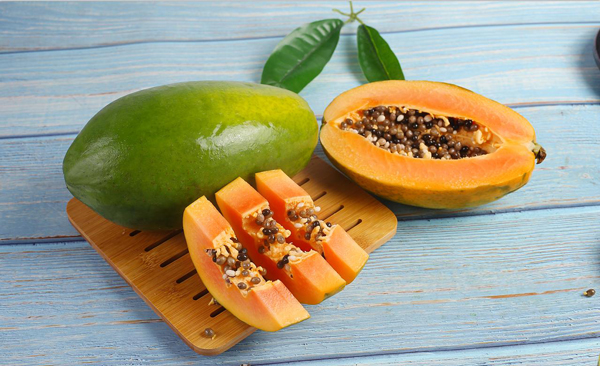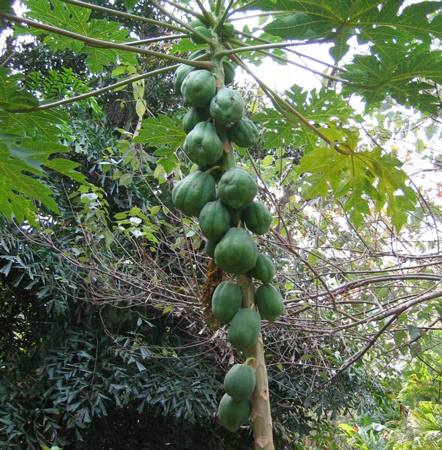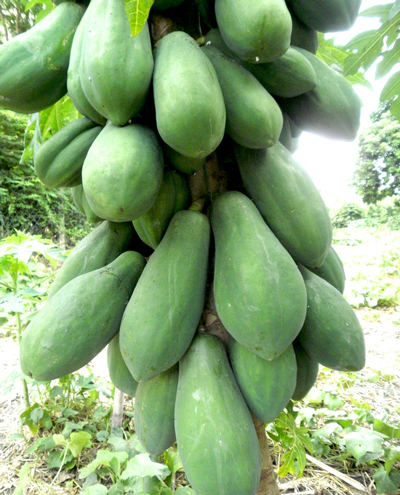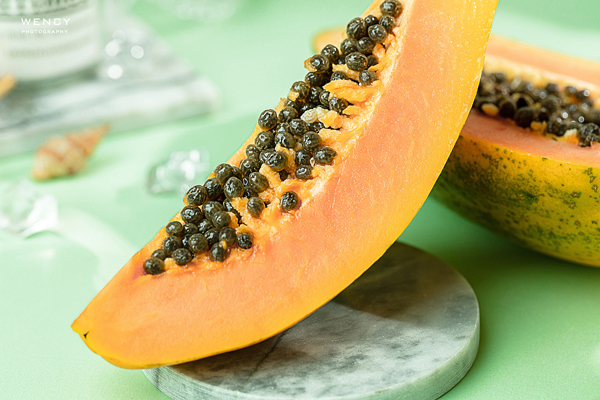Papaya (Carica papaya) Profile
Written by Iris
Aug 06 2021

The papaya tree (Carica papaya) is a tropical fruit native to Mexico and South America. It is now found throughout tropical North America and other tropical parts of the world. There are many varieties of papaya, but the main varieties grown in the United States are Red Lady, Maradol, and various Solo types. To grow papaya successfully, you need a frost-free climate, plenty of sun, plenty of water and good soil. If you give your plants all these conditions, then you can grow papayas from seeds, which usually bear fruit within six to 12 months.

It's believed that papaya is native to tropical America, with early origins in Mexico and South America. The fruit was brought into the Caribbean by indigenous people, and eventually made its way to Europe and the Pacific Islands before being introduced to Hawaii in the 1800s. Today, Hawaii is the only U.S. state to commercially produce papaya. Most papayas are from either Hawaii or Mexico. Mexican papayas can weigh up to 10 pounds (lb) and grow more than 15 inches long. Hawaiian papayas are smaller, averaging about 1 lb.
Steps for Papaya (Carica papaya) Propagation with Grafting
Pawpaws can generally be grafted with success using multiple grafting and budding techniques. Take scions in the winter from dormant trees that are 2 to 3 years old and graft them onto other pawpaw rootstocks.
Temperature and Humidity
Papaya thrives best under warm, humid conditions. It is generally intolerant of strong winds and cold weather.

‘Bluestem’: rich flavor; thick flesh; recommend for Florida
‘Graham’: excellent flavor; the flesh is firm and juicy; small to medium size fruit; recommended for Texas.
‘Kamiya’: very sweet; juicy; small to medium-sized fruit; dwarf tree.
‘Mexican Red’: not as sweet as Hawaiian types; rose-colored flesh; medium to very large fruit.
‘Mexican Yellow’: very sweet and flavorful; yellow flesh; medium to large fruit, can grow up to 10 pounds.
‘Solo’: very sweet; reddish-orange flesh; bisexual flowers.
‘Sunrise’ (‘Sunrise Solo’): high sugar content; reddish-orange flesh; plant matures in 9 months to about 3 feet tall.
‘Sunset’ (‘Sunset Solo’): very sweet; small to medium-sized, pear-shaped fruit; orange-red skin and flesh; dwarf tree.
‘Vista Solo’: sweet in hot weather; yellow skin, orange-yellow flesh; self-fertile.
‘Waimanalo’ (‘Waimanalo Solo, X-77’): very good flavor; round fruit; orange-yellow flesh.
Virus diseases are quite common and uncontrollable. They normally cause vein-clearing and yellow mottling of the leaves. Other symptoms include distortion of leaf growth accompanied by stunting, poor set and the presence of various greasy-appearing or yellow rings on leaves and fruit. Infected plants should be removed and destroyed.
Anthracnose appears on the fruit as irregular, water-soaked spots that later enlarge, darken and become sunken in the rind. Copper sprays have been of limited effect in severe situations, but would not be expected to be of much use under normal conditions in Texas.
Common whitefly is about the only insect pest which has affected papaya in Texas, leading to sooty mold on the foliage and fruit. Sweetpotato whitefly also is reported to favor papaya. The safest control is through spraying with a soapy water solution.
Tip burn and marginal necrosis (browning) of the leaves is caused by saline soil and water conditions common in much of Texas. Symptoms are usually more severe on older leaves and during the summer.
Papaya (Carica papaya) PicturePapaya (Carica papaya) InfoPapaya (Carica papaya) Distribution AreaHow to Grow and Care for Papaya (Carica papaya)Papaya (Carica papaya) Harvest and StorageUses of Papaya (Carica papaya)Varieties of Papaya (Carica papaya)
Papaya (Carica papaya) Picture

Papaya (Carica papaya) Info
| Botanical Name | Carica papaya |
| Common Name | Papaya |
| Plant Type | Semi-woody herbaceous perennial |
| Mature Size | 15–30 feet tall, 3–10 feet wide (smaller when grown as houseplants) |
| Sun Exposure | Full sun |
| Soil Type | Loose, rich potting mix |
| Soil pH | 5.5 to 7.0 (acidic to neutral) |
| Bloom Time | Rarely blooms indoors |
Papaya (Carica papaya) Distribution Area
Papaya is a soft tropical fruit with a yellowish-orange color. This species of fruit — which belongs to the Caricaceae family — is round and plump and comes in larger and smaller sizes.It's believed that papaya is native to tropical America, with early origins in Mexico and South America. The fruit was brought into the Caribbean by indigenous people, and eventually made its way to Europe and the Pacific Islands before being introduced to Hawaii in the 1800s. Today, Hawaii is the only U.S. state to commercially produce papaya. Most papayas are from either Hawaii or Mexico. Mexican papayas can weigh up to 10 pounds (lb) and grow more than 15 inches long. Hawaiian papayas are smaller, averaging about 1 lb.

How to Grow and Care for Papaya (Carica papaya)
How to Grow Papaya (Carica papaya)
- With Seeds
Steps for Papaya (Carica papaya) Propagation with Grafting
Pawpaws can generally be grafted with success using multiple grafting and budding techniques. Take scions in the winter from dormant trees that are 2 to 3 years old and graft them onto other pawpaw rootstocks.
- With Cuttings
How to Care for Papaya (Carica papaya)
- Light
- Soil
- Water
Temperature and Humidity
Papaya thrives best under warm, humid conditions. It is generally intolerant of strong winds and cold weather.
- Fertilizer
- Pruning

Papaya (Carica papaya) Harvest and Storage
Papaya fruit may be harvested green for use as a vegetable and ripe when full yellow to orange color develops on the peel. Generally, fruit may be picked when yellow color covers 1/10th to 1/3rd of the surface peel, however, greater color development of the fruit while on the tree increases fruit sugar content. After picking, fruit should be placed at room temperature to fully ripen before being stored in the refrigerator. Ripe fruit will keep up to 4 to 7 days.Uses of Papaya (Carica papaya)
Culinary. Grown throughout the tropics for the edible fruit.- Medicinal
- Edible

Varieties of Papaya (Carica papaya)
‘Betty’: excellent flavor; very tender flesh; quick to bear fruit.‘Bluestem’: rich flavor; thick flesh; recommend for Florida
‘Graham’: excellent flavor; the flesh is firm and juicy; small to medium size fruit; recommended for Texas.
‘Kamiya’: very sweet; juicy; small to medium-sized fruit; dwarf tree.
‘Mexican Red’: not as sweet as Hawaiian types; rose-colored flesh; medium to very large fruit.
‘Mexican Yellow’: very sweet and flavorful; yellow flesh; medium to large fruit, can grow up to 10 pounds.
‘Solo’: very sweet; reddish-orange flesh; bisexual flowers.
‘Sunrise’ (‘Sunrise Solo’): high sugar content; reddish-orange flesh; plant matures in 9 months to about 3 feet tall.
‘Sunset’ (‘Sunset Solo’): very sweet; small to medium-sized, pear-shaped fruit; orange-red skin and flesh; dwarf tree.
‘Vista Solo’: sweet in hot weather; yellow skin, orange-yellow flesh; self-fertile.
‘Waimanalo’ (‘Waimanalo Solo, X-77’): very good flavor; round fruit; orange-yellow flesh.
Papaya (Carica papaya) Common Pests/Diseases
Root rots can cause rapid death of papaya plants. The only solution is to set new plants in a better location with better drainage or use raised beds. Watering must be done with care.Virus diseases are quite common and uncontrollable. They normally cause vein-clearing and yellow mottling of the leaves. Other symptoms include distortion of leaf growth accompanied by stunting, poor set and the presence of various greasy-appearing or yellow rings on leaves and fruit. Infected plants should be removed and destroyed.
Anthracnose appears on the fruit as irregular, water-soaked spots that later enlarge, darken and become sunken in the rind. Copper sprays have been of limited effect in severe situations, but would not be expected to be of much use under normal conditions in Texas.
Common whitefly is about the only insect pest which has affected papaya in Texas, leading to sooty mold on the foliage and fruit. Sweetpotato whitefly also is reported to favor papaya. The safest control is through spraying with a soapy water solution.
Tip burn and marginal necrosis (browning) of the leaves is caused by saline soil and water conditions common in much of Texas. Symptoms are usually more severe on older leaves and during the summer.
Latest Updated
- Benefits of Bugleweed - 7 Science-backed Health Benefits
- Bugleweed Dangers & Side Effects - Is It Poisonous?
- How to Plant Evergreen Trees - What You Should Know
- When to Plant Evergreens - Grow Guide for Evergreen Trees
- 12 Wonderful Evergreen Shrubs for Your Garden
- 12 Popular Evergreen Plants with Pictures for Beginners
- When And How To Prune A Lilac Bush Like a Pro
- How to Grow & Care for Lilac Vine (Hardenbergia Violacea)
- Japanese Lilac Tree (Syringa Reticulata) Care & Propagation Guide
- Shumard Oak Pros and Cons - What to Know
Popular Articles
- Winter maintenance of Antirrhinum Majus
- How to Grow Terminalia Mantaly Tree
- How to Grow and Care for Crossostephium Chinense
- How to grow Antirrhinum Majus in spring
- Peristeria Elata (Dove Orchid) Profile: Info & Care Guide
- Underwatered Snake Plant (Sansevieria Trifasciata) - Signs And How To Fix
- How to Care for Brazilian Jasmine Plant (Mandevilla Sanderi)
- How to Grow & Care for Graptopetalum Purple Delight in Summer
- Rosa Chinensis (China Rose): Plant Growing & Care Tips
- How to Care for Baby Sun Rose (Aptenia Cordifolia)